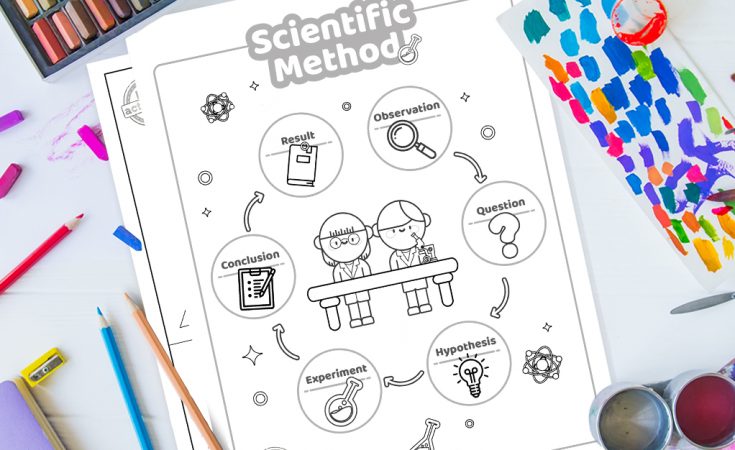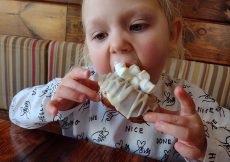Today we are learning the steps of the scientific method in a super easy way. It is the way that real scientists move from an educated guess to a logical answer with steps that can be repeated in a systematic way. These are the basic steps to all scientific inquiry.

Scientific Method Steps Explained Simply
Step 1 – Observation
There are tons of things happening around us all the time. Focus your attention on something that makes you curious. Most science experiments are based on a problem or question that doesn’t seem to have an answer.
In the first step of scientific method, your observations will lead you to a question: what, when, who, which, why, where or how. This initial question leads you into the next series of steps…
Step 2 – Question
The next step is to look at what would you like to know about it? Why do you want to know it? Find a good question that you can do some further research on…
This step also includes doing background research, a literature review and investigation into common knowledge about what is already known about the topic that surrounds your question. Has someone already conducted an experiment that looked into the question? What did they find?
Step 3 – Hypothesis
The word hypothesis is one that you will hear a bunch related to scientific experiments, but what does it actually mean? Here is a simple definition of the word, hypothesis:
A hypothesis (plural hypotheses) is a precise, testable statement of what the researcher(s) predict will be the outcome of the study.
–Simply Psychology, What is a hypotheses?
So basically, a hypothesis is an educated guess as to what you think the answer to your question will be when tested. It is a predication about what you think will happen when you do the science experiment.
A good hypothesis can be formatted like this:
If (I do this action), then (this) will happen:
- The “I do this action” is called an independent variable. That is a variable that the researcher changes based on the experiment.
- The “this” is called the dependent variable which is what the research measures.
This type of hypothesis is called an alternative hypothesis which states there is a relationship between the two variables and that one has an effect on the other.
Step 4 – Experiment
Design and perform an experiment to test your hypothesis and look at different ways to draw conclusions through scientific investigation. Think about creating an experiment that could be repeated by someone or yourself multiple times the same way. This means that it needs to be simple with only one change made each time you do the experiment.
Make sure you outline the experiment fully and collect data.
Step 5 – Conclusion
Once your experiment is done, analyze your data and the results of your experiment. See if the data matches your prediction.
Did you know that many science experiments actually don’t prove the expected results? Scientists use this knowledge to build on what they know and will go back and start with a new hypothesis based on what they learned.
It is common for the results of the experiment not support the original hypothesis!
Step 6 – Present Results
In the final step, a really big part of the scientific process is to share what you learned with others. For some scientists this might mean to write the findings of the experiment in a paper published in scientific journals. For students, it might mean creating a science fair poster or writing a final report paper for a class.
Communicate what did you learn? Was your prediction right? Do you have new questions?

Print a Scientific Method Step Worksheet
To make it easier to understand the steps of the scientific method, we have created a blank worksheet with all the steps listed that will let you outline your next experiment.
Reinforce the Scientific Method Steps Through Printable Science Worksheets
To reinforce the steps of the scientific method, we have created a printable set of scientific method worksheets that double as science coloring pages. These science printables work great for kids of all ages and adults who are trying to break down complicated scientific steps into simple lesson plans.

1. Scientific Method Steps Coloring Page
The first scientific steps printable worksheet is a visual guide of the steps with pictures to reinforce the meaning behind each step:
- Observation
- Question
- Hypothesis
- Experiment
- Conclusion
- Result
2. How to Use the Scientific Method
The second printable page goes into more detail about each of the scientific steps and works great as a resource when outlining a new experiment idea

Our second printable includes important details for each of the steps. This is a great resource for kids to use as a reference when performing their own experiments!
Science Experiment Vocabulary that is Helpful
1. Control Group
A control group in a scientific experiment is a group separated from the rest of the experiment, where the independent variable being tested cannot influence the results. This isolates the independent variable’s effects on the experiment and can help rule out alternative explanations of the experimental results.
–ThoughtCo, What is a Control Group?
A control group can help scientists make sure that one thing actually influences another and isn’t just happening by chance.
2. Francis Bacon
Francis Bacon is attributed with being the father of the scientific method:
…Bacon was determined to alter the face of natural philosophy. He strove to create a new outline for the sciences, with a focus on empirical scientific methods—methods that depended on tangible proof—while developing the basis of applied science.
–Biography, Francis Bacon
3. Scientific Law & Scientific Theory
A scientific law describes an observed phenomenon, but doesn’t explain why it exists or what caused it.
The explanation of a phenomenon is called a scientific theory.
–Live Science, What is a Law in Science Definition of Scientific Law
4. Null Hypothesis
A null hypothesis states there is no difference between two variables and is usually a type of hypothesis that a scientist or researcher is trying to disprove. I think of it as almost the opposite of the alternative hypothesis. Sometimes experimenters will make both an alternative and null hypothesis for their experiment.
More Science Fun from Kids Activities Blog
How are you using the scientific method steps? What is your next science experiment?



































